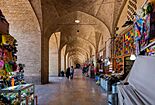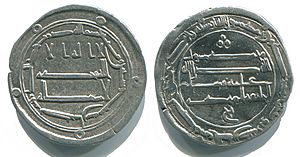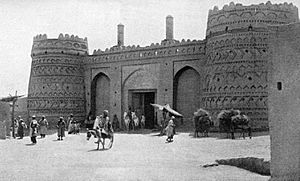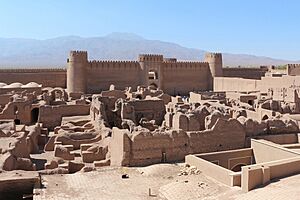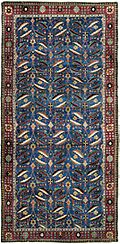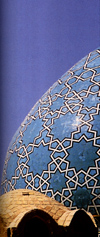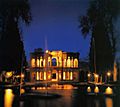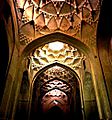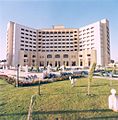Kerman facts for kids
Quick facts for kids
Kerman
Persian: کرمان
Kārmānia, Boutiā, Carmānia, Karmana
|
||
|---|---|---|
|
City
|
||
|
|
||
|
||
| Nickname(s):
ديار كريمان (Persian for "Land of Karimans"), The City of Stars
|
||
| Country | Iran | |
| Province | Kerman | |
| County | Kerman | |
| District | Central | |
| Founded | c. 3rd century AD | |
| Area | ||
| • City | 220 km2 (92.22 sq mi) | |
| Elevation | 1,755 m (5,758 ft) | |
| Population
(2016)
|
||
| • City | 537,718 | |
| • Urban | 738,374 | |
| • Population Rank in Iran | 10th | |
| Demonym(s) | Kermani | |
| Time zone | UTC+3:30 (IRST) | |
| Postal code |
761
|
|
| Area code(s) | +98 343 | |
| Main language(s) | Persian | |
| Climate | BWk | |
Kerman (Persian: كرمان) is a big city in Iran. It's the capital of Kerman Province and Kerman County. This city is known for its long history and rich cultural heritage. It's located in southeastern Iran, about 800 kilometers (500 miles) southeast of Tehran, the capital of Iran. Kerman is one of the largest and most developed cities in its region.
Contents
Kerman's Long History
Kerman was first built as a military outpost around the 3rd century AD. It was founded by Ardashir I, who started the Sasanian Empire. Back then, it was called Veh-Ardashir.
Early Muslim Rule and Growth
After a big battle in 642, Kerman came under Muslim rule. For a while, its remote location allowed some groups, like the Kharijites and Zoroastrians, to live freely there. By the 700s, most people in Kerman were Muslim. In the 8th century, the city became famous for making fine cashmere wool shawls and other fabrics.
Kerman Under Different Rulers
The city was ruled by different groups over time. In the 10th century, the Buyid emirs took control. Later, Mahmud of Ghazni's forces captured it. The name Kerman became official around this time.
Under the Seljuk Turks in the 11th and 12th centuries, Kerman was almost like its own country. It even took over areas like Oman and Fars. When the famous traveler Marco Polo visited Kerman in 1271, it was a busy trading hub. It connected the Persian Gulf with other important regions like Khorasan and Central Asia.
Challenges and Rebuilding
Sadly, Kerman was attacked and damaged many times by different invaders. The city grew a lot during the Safavid dynasty. During this time, beautiful carpets and rugs from Kerman were sent to countries like England and Germany.
In the late 1700s, Kerman faced a very difficult period. After a long siege, the city was captured by Agha Mohammad Khan Qajar. Many people suffered, and the city was left in ruins.
The Kerman we see today was rebuilt in the 1800s, a bit to the northwest of the old city. It took until the 20th century for Kerman to become as big and important as it once was.
People and Population
Who Lives in Kerman?
Most people in Kerman are Persians, and they are mostly Muslim. There is also a small group of Zoroastrians living in the city.
How Many People Live Here?
Kerman has grown quite a bit over the years.
- In 1996, about 385,000 people lived in Kerman.
- By 2006, the population was around 496,684.
- In 2011, it grew to 534,441 people.
- The most recent census in 2016 showed 537,718 people living in Kerman.
Kerman is the largest and most developed city in its province. It's also one of the most important cities in southeastern Iran. The city is very large in terms of its area.
Kerman's Population Growth Over Time
Here's how Kerman's population has changed:
|
|
¹ official census results
Geography and Climate
Where is Kerman Located?
Kerman is found on a high edge of the Lut Desert in south-central Iran. Mountains surround the city. It's also near the Saheb Al Zaman mountain. Kerman is 1,755 meters (5,758 feet) above sea level. This makes it one of the highest provincial capitals in Iran.
Kerman's Weather
Kerman has a cold desert climate. This means it has hot summers and cool to cold winters. It doesn't rain much throughout the year. The average yearly rainfall is about 148 millimeters. Even so, its climate is fairly cool compared to other parts of Iran.
The city's different areas are surrounded by mountains. The northern part of Kerman is in a dry desert area. But the higher parts in the south have a milder climate.
| Climate data for Kerman – Altitude: 1753.8 m (1951–2010, records 1951–2020) | |||||||||||||
|---|---|---|---|---|---|---|---|---|---|---|---|---|---|
| Month | Jan | Feb | Mar | Apr | May | Jun | Jul | Aug | Sep | Oct | Nov | Dec | Year |
| Record high °C (°F) | 24.4 (75.9) |
29.4 (84.9) |
32.9 (91.2) |
35.0 (95.0) |
38.8 (101.8) |
41.6 (106.9) |
42.0 (107.6) |
42.3 (108.1) |
39.0 (102.2) |
35.0 (95.0) |
31.1 (88.0) |
28.0 (82.4) |
42.3 (108.1) |
| Mean daily maximum °C (°F) | 12.2 (54.0) |
14.9 (58.8) |
19.0 (66.2) |
24.4 (75.9) |
30.1 (86.2) |
35.0 (95.0) |
35.8 (96.4) |
34.4 (93.9) |
31.5 (88.7) |
26.1 (79.0) |
19.6 (67.3) |
14.4 (57.9) |
24.8 (76.6) |
| Daily mean °C (°F) | 4.6 (40.3) |
7.3 (45.1) |
11.4 (52.5) |
16.4 (61.5) |
21.2 (70.2) |
25.6 (78.1) |
26.8 (80.2) |
24.6 (76.3) |
21.1 (70.0) |
15.9 (60.6) |
10.0 (50.0) |
5.9 (42.6) |
15.9 (60.6) |
| Mean daily minimum °C (°F) | −3.1 (26.4) |
−0.3 (31.5) |
3.8 (38.8) |
8.3 (46.9) |
12.4 (54.3) |
16.2 (61.2) |
17.8 (64.0) |
14.8 (58.6) |
10.7 (51.3) |
5.7 (42.3) |
0.4 (32.7) |
−2.6 (27.3) |
7.0 (44.6) |
| Record low °C (°F) | −30.0 (−22.0) |
−20.0 (−4.0) |
−10.2 (13.6) |
−3.0 (26.6) |
1.0 (33.8) |
7.0 (44.6) |
8.0 (46.4) |
2.0 (35.6) |
−1.0 (30.2) |
−10.0 (14.0) |
−15.0 (5.0) |
−25.0 (−13.0) |
−30.0 (−22.0) |
| Average precipitation mm (inches) | 28.8 (1.13) |
25.2 (0.99) |
33.1 (1.30) |
18.7 (0.74) |
10.8 (0.43) |
1.1 (0.04) |
1.4 (0.06) |
0.5 (0.02) |
0.3 (0.01) |
1.5 (0.06) |
5.6 (0.22) |
21.0 (0.83) |
148 (5.83) |
| Average snowfall cm (inches) | 3.7 (1.5) |
1.0 (0.4) |
0.1 (0.0) |
0.0 (0.0) |
0.0 (0.0) |
0.0 (0.0) |
0.0 (0.0) |
0.0 (0.0) |
0.0 (0.0) |
0.0 (0.0) |
0.0 (0.0) |
2.6 (1.0) |
7.4 (2.9) |
| Average precipitation days (≥ 1.0 mm) | 4.2 | 4 | 4.7 | 3.2 | 1.5 | 0.1 | 0.2 | 0.2 | 0.1 | 0.6 | 1.4 | 3 | 23.2 |
| Average rainy days | 4.7 | 5.3 | 6.7 | 4.5 | 1.9 | 0.4 | 0.3 | 0.4 | 0.1 | 0.9 | 2.6 | 3.6 | 31.4 |
| Average snowy days | 2.2 | 1.0 | 0.4 | 0 | 0 | 0 | 0 | 0 | 0 | 0 | 0.1 | 1.0 | 4.7 |
| Average relative humidity (%) | 53 | 46 | 41 | 34 | 26 | 19 | 19 | 20 | 21 | 28 | 37 | 48 | 33 |
| Average dew point °C (°F) | −10.3 (13.5) |
−9.4 (15.1) |
−8.5 (16.7) |
−6.1 (21.0) |
−5.7 (21.7) |
−6.1 (21.0) |
−5.1 (22.8) |
−6.1 (21.0) |
−7.6 (18.3) |
−7.8 (18.0) |
−9.1 (15.6) |
−10.4 (13.3) |
−7.7 (18.2) |
| Mean monthly sunshine hours | 198.4 | 200.0 | 223.5 | 237.5 | 298.0 | 323.6 | 339.1 | 337.5 | 310.3 | 283.9 | 241.9 | 206.4 | 3,200.1 |
| Source 1: IRIMO | |||||||||||||
| Source 2: NOAA(precipitation days - dew point 1991-2020, snowfall 1981-2010) | |||||||||||||
Ancient Fossils in Kerman
Kerman is a special place for paleontologists, who study ancient life. In 2005, new dinosaur footprints were found here. This discovery helps scientists learn more about the area's history.
Kerman's Economy
Kerman's economy mainly relies on farming and mining.
Farming and Mining
Growing nuts, especially Pistachios, is a very important part of Kerman's economy. The region also has valuable minerals like copper and coal.
Famous Kerman Carpets
Carpet weaving is one of the oldest and most important industries in Kerman. The carpets made here are famous all over the world! People have been weaving carpets in Kerman for at least 500 years. The city also makes cotton textiles and shawls from goat wool.
Culture and Traditions
Kerman is rich in culture and traditions.
Zoroastrian Museum
Kerman has the only Iranian anthropology museum dedicated to Zoroastrianism. This museum is located in Kerman's Fire Temple. It shows the ancient history of Zoroastrians in the area. The idea for the museum started in 1983, and it officially opened in 2005.
Festivals and Ceremonies
- Jashn-e Tirgan or Tiregan is an old Iranian festival celebrated on July 1st. It's a rain festival that honors the archangel Tir, who brings thunder and lightning for rain.
- The Sadeh ceremony is another ancient festival celebrated every year in Kerman.
Historic Sites and Handicrafts
Near Kerman, you can find the ancient archaeological sites of Jiroft and Tappe Yahya Baft. The impressive Rayen Castle is also located southeast of Kerman.
Kerman is also known for its beautiful handicrafts and souvenirs. These include:
- Pateh: A traditional embroidery.
- Carpets and rugs: Famous worldwide.
- Jajeems and kilims: Types of woven carpets.
- Satchels and other handmade items.
- Caraway seeds and pistachios from the region are also very popular.
Sports in Kerman
Kerman has many sports teams.
- Mes Kerman is the city's main football (soccer) team. They have played in Iran's top league and even in the AFC Champions League.
- The MES handball team and MES cycling team are also in the country's top leagues.
- The MES chess team plays in the first league.
- Kerman's baseball team, the Boshra Baseball Academy, won the national baseball cup in 2013.
Sports Venues
Kerman has several sports facilities:
- Shahid Bahonar Stadium (15,000 seats)
- A new 30,000-seat stadium for the MES soccer team (under construction)
- Salimi Kia Stadium
- Sports Complex of Imam Ali
- Sirch Ski Resort
- An international Kart racing track
Media and News
Kerman is a center for media in Kerman Province.
- Newspapers like Kerman Emruz (Kerman Today) and Bidari are published here.
- Hadis–Pasargad is a weekly newspaper.
- Kerman has its own 24-hour TV channel, called Kerman Channel or Channel 5.
- The city also has a radio station.
Getting Around Kerman
Kerman is an important transportation hub.
- Roads: Kerman is on major roads connecting Tehran, Bandar Abbas, and Zahedan.
- Airport: Ayatollah Hashemi Rafsanjani Airport is one of Iran's main airports. It has daily and weekly flights to many Iranian cities.
- Train: The Trans-Iranian Railway passes through Kerman.
- Bus: Kerman's modern bus station, Adineh, opened in 2013.
Future Transportation Plans
- A metro (subway) system was planned for Kerman, but the project was stopped.
- In 2016, an agreement was made to build a new railway connecting Chabahar and Zahedan. This railway is part of a larger plan to improve transportation in the region.
Universities and Colleges
Kerman is home to several important universities and colleges:
- Kerman Azad University
- Shahid Bahonar University of Kerman (a technology university)
- Kerman University of Medical Sciences (a medical university)
- Kerman Graduate University of Technology (for advanced degrees)
- Shahid Chamran Technical College of Kerman
- Payam Noor University of Kerman
- Kerman Khaje-Nasir Higher Education Center
Famous People from Kerman
Many notable people come from Kerman, including:
- Al-Mahani (a 9th-century mathematician and astronomer)
- Khwaju Kermani (a 14th-century poet)
- Shah Nimatullah Wali (a 14th-century spiritual leader and poet)
- Ganj Ali Khan (a 16th-century governor)
- Qasem Soleimani (a military commander)
- Mohammad Javad Bahonar (a former Prime Minister of Iran)
- Houshang Moradi Kermani (a famous writer)
- Zahra Nemati (a Paralympic archery gold medalist)
- Tahereh Saffarzadeh (a poet and writer)
Sister City
Kerman has one sister city:
 Armavir, Armenia
Armavir, Armenia
Images for kids
-
Kerman's Grand Bazaar
See also
 In Spanish: Kermán para niños
In Spanish: Kermán para niños





